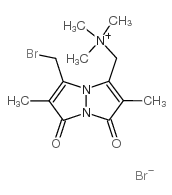Monobromo(trimethylammonio)bimane bromide

Monobromo(trimethylammonio)bimane bromide structure
|
Common Name | Monobromo(trimethylammonio)bimane bromide | ||
|---|---|---|---|---|
| CAS Number | 71418-45-6 | Molecular Weight | 409.11700 | |
| Density | N/A | Boiling Point | N/A | |
| Molecular Formula | C13H19Br2N3O2 | Melting Point | 222-228ºC (dec.) | |
| MSDS | USA | Flash Point | N/A | |
|
Cell surface thiols, but not intracellular glutathione, are essential for cytolysis by a cloned murine natural killer cell line.
Immunol. Invest. 14(5) , 401-14, (1985) Cell surface thiols are required for a line of cloned murine natural killer lymphocytes to bind to and lyse tumor target cells. These lymphocytes neither bound to nor killed YAC-1 or G1Tc cells when the effector lymphocyte cell surface thiols were covalently ... |
|
|
The open/closed conformational equilibrium of aspartate aminotransferase. Studies in the crystalline state and with a fluorescent probe in solution.
Eur. J. Biochem. 196 , 329, (1991) Aspartate aminotransferase undergoes major shifts in the conformational equilibrium of the protein matrix during transamination. The present study defines the two conformational states of the enzyme by crystallographic analysis, examines the conditions under ... |
|
|
Thiol labeling with bromobimanes.
Meth. Enzymol. 143 , 76, (1987)
|
|
|
Localization of thiol and disulfide groups in guinea pig spermatozoa during maturation and capacitation using bimane fluorescent labels.
Biol. Reprod. 31(4) , 797-809, (1984) The distribution of thiols and disulfides in the guinea pig spermatozoon during maturation and capacitation was studied using both membrane-permeable (mBBr) and impermeable (qBBr) forms of bromobimane, a specific fluorescent probe for thiol groups. In conjunc... |
|
|
Protein disulfide isomerase mediates integrin-dependent adhesion.
FEBS Lett. 475(2) , 89-92, (2000) Cell adhesion is mediated by the integrin adhesion receptors. Receptor-ligand interaction involves conformational changes in the receptor, but the underlying mechanism remains unclear. Our earlier work implied a role for sulfhydryls in integrin response to li... |
|
|
Conformational changes in mitochondrial aspartate aminotransferase detected by a covalently attached fluorescent probe.
Prog. Clin. Biol. Res. 144B , 117-24, (1984)
|
|
|
Analysis of biological thiols: derivatization with monobromotrimethylammoniobimane and characterization by electrophoresis and chromatography.
Anal. Biochem. 107(1) , 1-10, (1980) A new method for analysis of biological thiols based upon their conversion to fluorescent derivatives by reaction with monobromotrimethylammoniobimane (qBBr) is described. The derivatives are separated by chromatography and by electrophoresis on cellulose thi... |
|
|
Fluorescent localization of thiols and disulfides in marsupial spermatozoa by bromobimane labelling.
Mol. Reprod. Dev. 37(3) , 318-25, (1994) The acrosome of marsupial spermatozoa is a robust structure which, unlike its placental counterpart, resists disruption by detergent or freeze/thawing and does not undergo a calcium ionophore induced acrosome reaction. In this study specific fluorescent thiol... |
|
|
Estimation of reactive thiol concentrations in dissolved organic matter and bacterial cell membranes in aquatic systems.
Environ. Sci. Technol. 46(18) , 9854-61, (2012) Organic thiols are highly reactive ligands and play an important role in the speciation of several metals and organic pollutants in the environment. Although small thiols can be isolated and their concentrations can be estimated using chromatographic and deri... |
|
|
Flexibility of the Kir6.2 inward rectifier K(+) channel pore.
Proc. Natl. Acad. Sci. U. S. A. 98(7) , 4227-32, (2001) Interactions of sulfhydryl reagents with introduced cysteines in the pore-forming (Kir6.2) subunits of the K(ATP) channel were examined. 2-Aminoethyl methanethiosulfonate (MTSEA(+)) failed to modify Cd(2+)-insensitive control-Kir6.2 channels, but rapidly and ... |